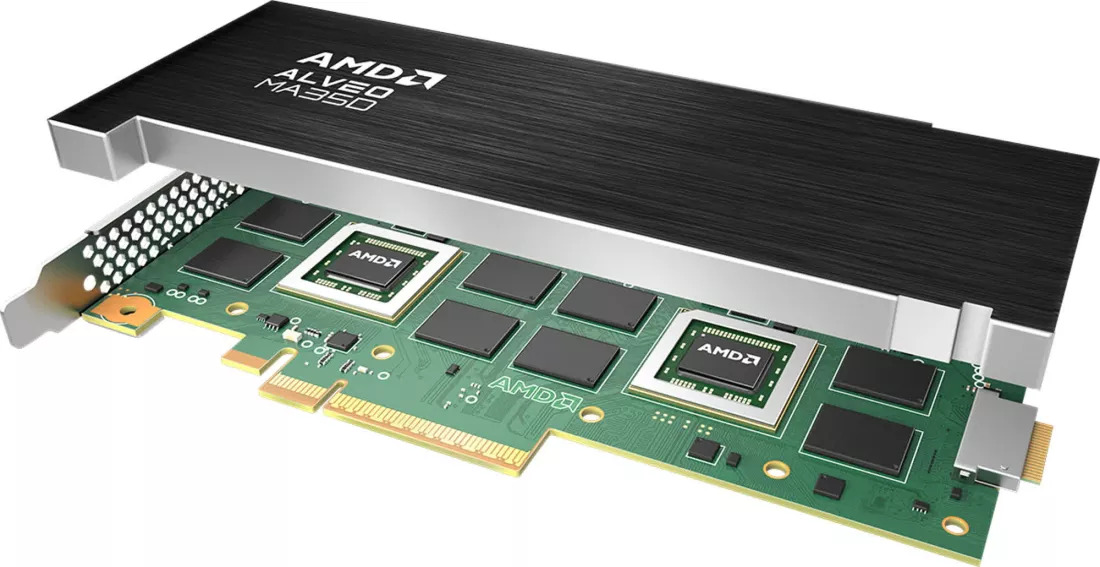Alveo MA35D is AMD’s new media accelerator for efficient video streaming

In context: The global video market is now being dominated by live streaming services, and content providers need a hardware infrastructure able to efficiently manage those services at scale. AMD is bringing a new, purpose-built chip to these companies.
AMD has officially introduced its new graphics product for the data center market: Alveo MA35D is a media accelerator built upon a specialized ASIC architecture, with a Video Processing Unit (VPU) designed for high-density, “ultra” low-latency media streaming for live services. In AMD’s opinion, Alveo MA35D should provide significant benefits for a new class of low-latency streaming applications while reducing infrastructure costs at the same time.
Alveo ‘s VPU is designed to “accelerate the entire video pipeline,” AMD said. The PCIe board can perform all video processing tasks within the dedicated VPU, so that data transfer between the CPU and the accelerator is minimized. Thus, overall latency is significantly reduced and channel density can be maximized with up to 32x 1080p60, 8x 4Kp60, or 4x 8Kp30 streams managed per card.
The Alveo MA35D board delivers up to 4x higher channel density and 4x max lower latency in 4K compared to the previous generation (Alveo U30), AMD said, providing 1.8x greater compression efficiency while achieving the same VMAF score. VMAF is a commonly used, objective full-reference video quality metric developed by Netflix.
AMD’s new media platform provides support for the most popular video codecs out there (H.264 and H.265), while featuring support for the next-generation AV1 codec to deliver up to a 52% reduction in bitrate for remarkable bandwidth savings at the same perceived video quality. According to Alliance for Open Media’s head Matt Frost, the new Alveo MA35D add-in card is an important step in building a “fully-fledged ecosystem to support royalty-free, high-definition video devices, products, and services.”
As the latest tech trends dictate, Alveo MA35D also provides an integrated AI processor designed to improve the quality of experiences at reduced bandwidth. The “intelligent video pipeline” enabled by the AI unit is constantly evaluating content, “frame-by-frame,” to dynamically adjust encoder settings and improve perceived visual quality while minimizing bitrate.
Alveo MA35D has been designed to help companies maximize the number of channels per server while minimizing power and bandwidth-per-stream, AMD said. A 1U rack server equipped with 8 cards can deliver up to 256 1080p60 channels (32x 1080p60 streams per card) at 1 watt per stream, providing significant efficiency per server, rack or data center.
Alveo MA35D media accelerators are sampling right now while the first shipments are expected for Q3, AMD said. The platform comes with a complete “Advanced Media Acceleration” suite, an open-source software development kit (SDK) which supports commonly used video frameworks like FFmpeg and Gstreamer, as well as a C API for complete customization of the video pipeline.

Your point of view caught my eye and was very interesting. Thanks. I have a question for you.
Your point of view caught my eye and was very interesting. Thanks. I have a question for you.
I don’t think the title of your article matches the content lol. Just kidding, mainly because I had some doubts after reading the article.
PlayAmo Portal Virtual Gambling Website is one of the best play destinations for gamblers who desire fun, deals, and efficient earnings.
With hundreds of top-notch jackpots, blackjack, and live dealer experiences, PlayAmo Casino delivers a world-class online trip right from your notebook or portable device.
New bettors can secure generous welcome bonuses, spin offers, and experience private VIP rewards.
Whether you prefer retro games or the modern titles, PlayAmo Online offers everything you need for engaging play for cash
https://gyn101.com/
gyn101.com